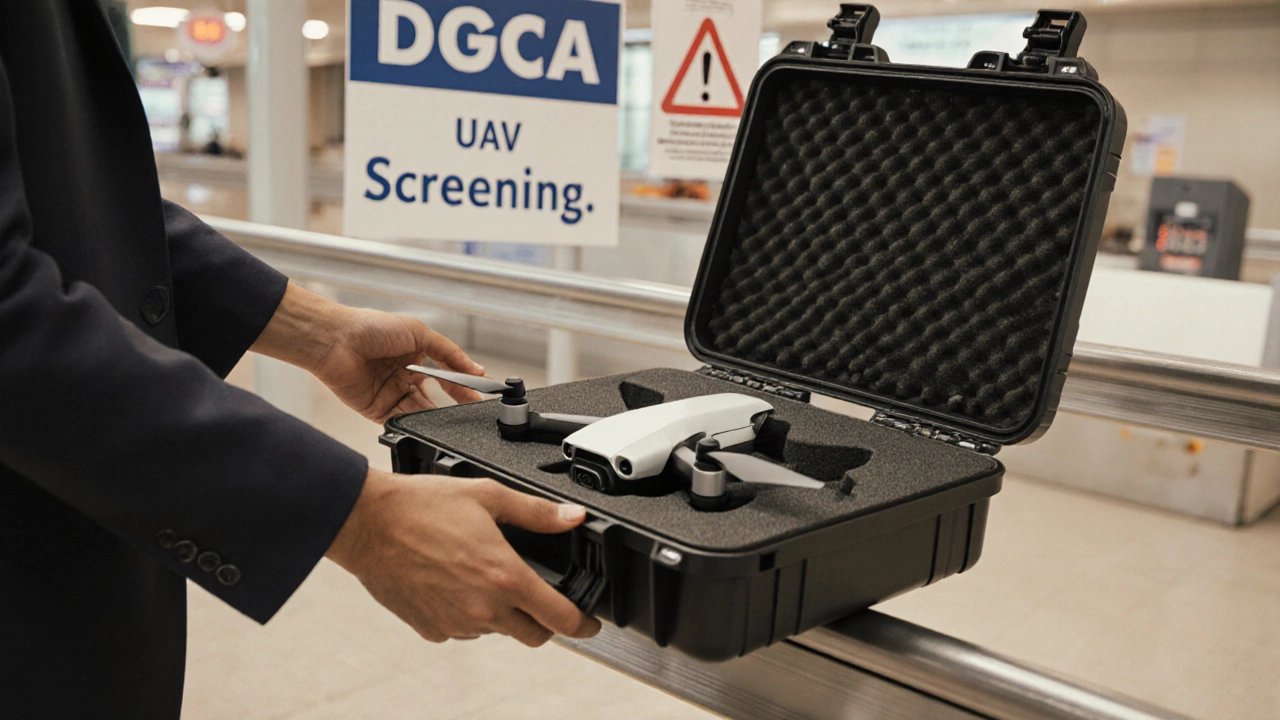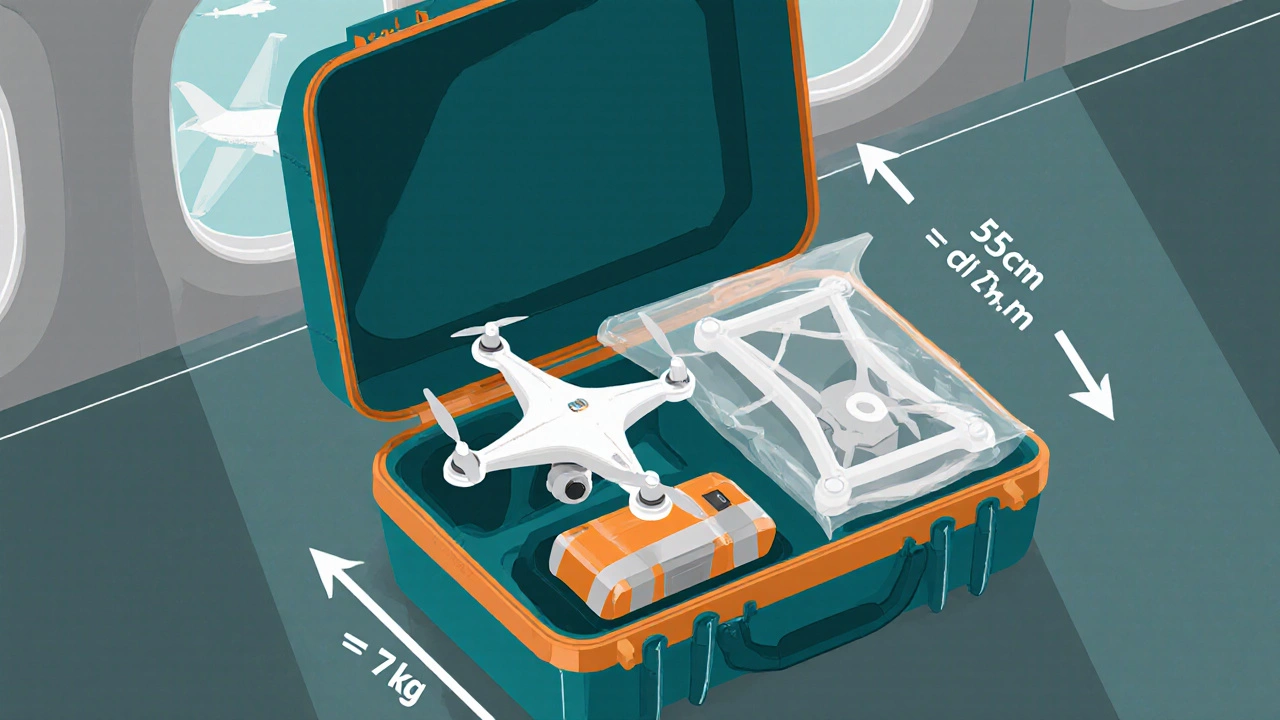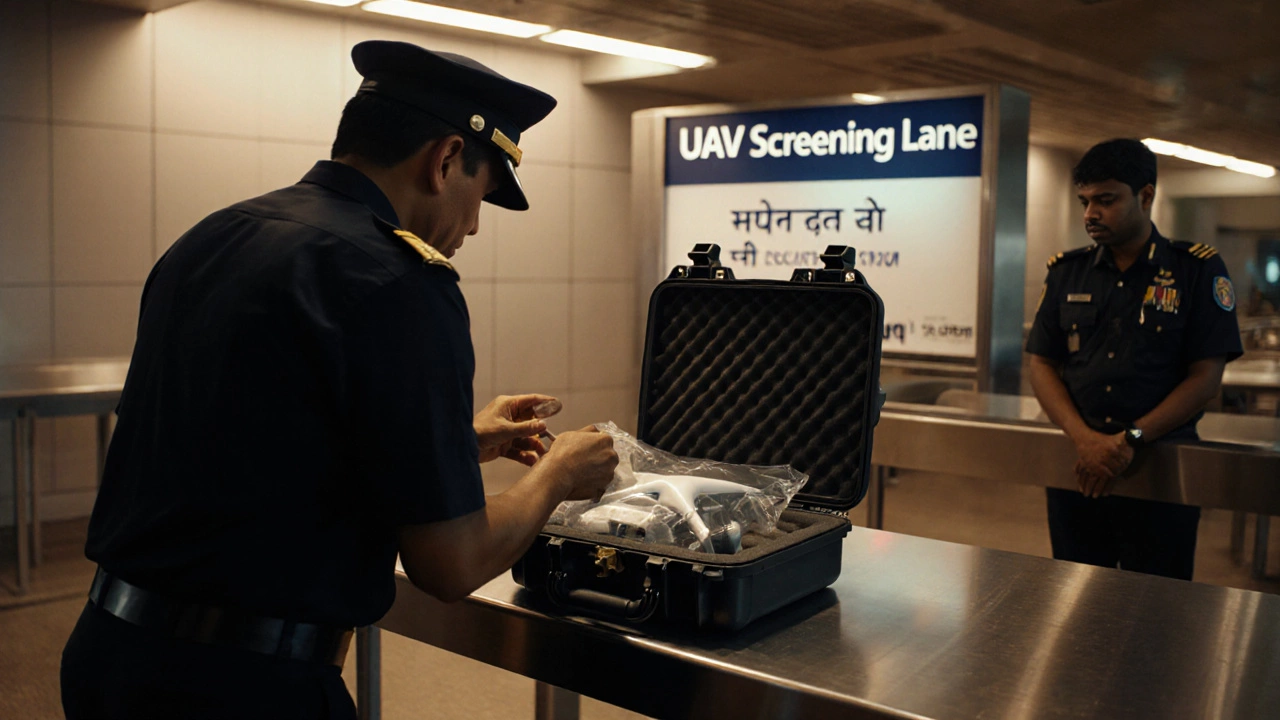Drone Hand Luggage Rules in India - What You Need to Know
 Oct, 20 2025
Oct, 20 2025
Drone Hand Luggage Compliance Checker for India
Check Your Drone's Compliance
Enter your drone's weight and battery capacity to determine if it meets Indian regulations for hand luggage.
Important: Always declare your drone at check-in and carry any required documentation.
When you’re gearing up for a photography trip across India, the first question that pops up is: drone hand luggage India - can you stash your flying camera in the overhead bin?
Drone is a remotely piloted aircraft, usually equipped with a camera, that belongs to the broader class of unmanned aerial vehicles (UAVs). Indian authorities treat it as electronic equipment with its own set of transport rules.
What the DGCA says about drones in cabin baggage
DGCA (Director General of Civil Aviation) is the regulatory body that publishes the Civil Aviation Requirements (CAR) governing air transport of drones. The latest amendment, CAR‑Standard 201, states that a drone may be carried in hand luggage provided it meets three conditions: it is under 7 kg, the battery capacity does not exceed 100 Wh, and the device is declared at check‑in.
The rule is clear - you cannot hide a 12‑kg racing drone in your bag without a special permit. If the drone exceeds the weight limit, you must either ship it as cargo or obtain a Temporary Permit from the DGCA, which involves paperwork, security clearance, and a fee.
Size, weight, and packaging guidelines
The hand‑luggage limit for most Indian airlines is 7 kg (15 lb) with dimensions not exceeding 55 cm × 35 cm × 25 cm. Your drone, folded or disassembled, must fit within these constraints. Many manufacturers design travel‑ready models that collapse into a compact case, but be honest with the airline - trying to sneak a larger drone often ends in a last‑minute repack.
Pack the drone in a rigid, padded case. A hard‑shell suitcase or a dedicated drone flight case with foam inserts protects the frame, propellers, and camera lens from bumps during boarding. Inside the case, separate the battery from the drone; most airlines ask you to place the battery in a zip‑lock bag and keep it readily accessible for inspection.
Batteries and electronic safety rules
Battery is a rechargeable lithium‑ion cell that powers most consumer drones. Because lithium‑ion cells pose a fire risk, the International Air Transport Association (IATA) limits them to 100 Wh for carry‑on and 160 Wh for checked baggage with airline approval.
Check the battery label; the Wh rating is printed on the side (e.g., 3S 11.1 V 2200 mAh ≈ 24.4 Wh). If the rating is above 100 Wh, you must either ship the battery separately as cargo or request an exemption from the airline’s cargo department well before travel.
Turn off the drone, remove propellers, and ensure the battery terminals are covered with tape. Pack each battery in an individual plastic bag - this prevents short‑circuits if the terminals touch metal surfaces inside the luggage.
Airline policies you’ll encounter in India
While the DGCA provides the baseline, each airline adds its own nuance. Below is a quick snapshot of the most common carriers:
- Air India: Allows drones up to 7 kg in hand luggage if the battery is ≤100 Wh. Declaration at check‑in is mandatory.
- IndiGo: Requires prior written permission for any drone larger than 5 kg. Batteries must be removed and presented separately.
- SpiceJet: Accepts drones as long as the total handheld weight (drone + battery) stays under 7 kg. Propellers must be detached.
- Vistara: Calls for a Drone Transport Form, downloadable from their website, and a photo of the drone’s serial number.
Because policies can change with short notice, always visit the airline’s “Baggage” or “Special Items” page a day before departure. If you’re unsure, email their customer support and reference the DGCA CAR‑201 clause - most agents will guide you through the paperwork.

Hand luggage vs. checked baggage: quick comparison
| Aspect | Hand Luggage | Checked Baggage |
|---|---|---|
| Weight limit | Up to 7 kg total (drone + battery) | No strict limit, but airline may cap at 15 kg |
| Battery capacity | ≤100 Wh (no approval needed) | Up to 160 Wh with airline consent; >100 Wh requires special paperwork |
| Declaration | Mandatory at check‑in; security may open the case | Mandatory in cargo manifest; often requires DGCA permit |
| Risk of damage | Higher - overhead bin impacts; use padded case | Lower - checked‑in cargo area is handled more gently, but still pack securely |
| Security screening | Battery inspected in the cabin; may trigger extra X‑ray | Battery screened with cargo; may be delayed if flagged |
How to clear security without hassle
Airport Security is a team of personnel responsible for screening passengers and luggage for prohibited items. When you pull out a drone case, they will likely ask you to open it.
Speed up the process by keeping the case zip unlocked and the battery in a separate clear bag. If you have a flight‑ready checklist on your phone, show it to the officer - it signals you’ve prepared properly.
Some airports (e.g., Delhi’s IGI) have a dedicated “UAV Screening Lane.” Look for signage or ask an attendant. Using that lane can shave off 10‑15 minutes compared to the regular queue.
Travel checklist for your drone
- Verify drone weight and dimensions against airline hand‑luggage limits.
- Read the battery label; ensure Wh ≤100 Wh for carry‑on.
- Pack the drone in a hard‑shell case with foam inserts.
- Remove propellers and place them in a separate zip‑lock bag.
- Cover battery terminals with tape and store each battery in its own plastic bag.
- Download the airline’s Drone Transport Form (if required) and fill it out.
- Declare the drone at check‑in; keep the declaration receipt handy.
- Arrive at the airport 2‑3 hours early for extra screening time.
- Have a copy of the DGCA CAR‑201 excerpt (optional but helpful).
- After landing, double‑check that the drone and batteries are still intact before leaving the terminal.
Following this list will save you from last‑minute surprises and let you focus on capturing those stunning aerial shots of the Taj Mahal, the backwaters of Kerala, or the bustling streets of Mumbai.
Can I bring a drone on a domestic flight within India?
Yes, provided the drone and its batteries stay within the airline’s hand‑luggage limits (usually 7 kg total) and you declare it at check‑in. Batteries must be ≤100 Wh unless you obtain special permission.

Do I need a DGCA permit to travel with a drone?
A permit is only required if the drone exceeds 7 kg, the battery exceeds 100 Wh, or you intend to operate the drone inside Indian airspace after arrival. For standard hobby‑grade drones that meet the limits, a simple declaration is enough.
Are there special rules for international flights leaving India?
International carriers follow IATA rules, which align with the DGCA’s domestic limits. However, the destination country may have its own import / export regulations, so check both ends before you fly.
What if my drone’s battery is 150 Wh?
A 150 Wh battery can only travel as checked baggage with airline approval. You’ll need to fill out a cargo declaration and may be subject to a security fee. Carry‑on is not allowed for that capacity.
Do I need to register my drone before traveling?
Registration with the DGCA is mandatory for all drones above 250 g used for commercial purposes. Hobbyists with sub‑250 g models are exempt, but having the registration number handy eases the security check.